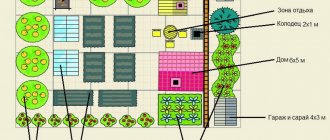Ideas for arranging beds
Modern summer cottages are rarely filled to capacity with beds. Usually they have space for a lawn, a swing, a playground, and a barbecue. But incorporating banal plantings of onions or tomatoes into the resulting decorative splendor may not be so easy.
In order not to turn your suburban paradise into a Soviet dacha, try to implement design solutions when growing vegetables.
Build vertical beds
Owners of small plots sometimes have a hard time when planning. After all, you want to place everything on your favorite acres at once, but there is almost no space left for planting. And if it is unrealistic to reduce the apple trees or barbecue, then, fortunately, with ridges this is quite feasible.
It is enough just to place your plantings not in a horizontal plane, as we are used to, but vertically.
Multi-tiered ridges, suspended wall structures, complex pyramids, and boxes on a fence are suitable for these purposes.
Plant a vegetable garden in containers
Are you actively planning your plot and don’t know what will be located where, but you want to harvest the crop this season?
Then for you – containers that roam around the territory, in which you can grow herbs and small amounts of vegetables. Containers can be either industrially produced or hand-made. The main thing is not to make them too deep so that the weight of the soil allows you to move the containers around the site.
Create a decorative vegetable garden (vegetables, herbs and flowers in one bed)
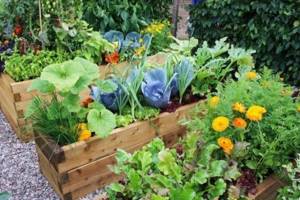
Do you always want to come to your garden with pleasure? Then plant vegetables and herbs mixed with flowers. The rich colors of marigolds, calendula, chamomile, hyssop or lavender will add decorative value to your plantings, and strong odors will repel pests.
Build raised beds from planed boards
If you have a traditional wooden house at your dacha, then high ridges made of planed boards will give the site uniformity and maintain the style.
On the outside, they can be either painted in bright colors or retain the natural shade of natural wood.
Don’t forget to impregnate the wood with special antifungal and protective biological agents - they will prolong the life of the structure and will not affect the planting in any way.
Make beds with decorative edges
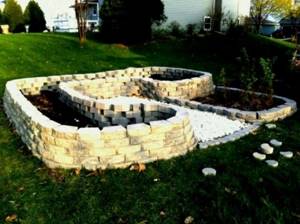
Not only beds made of boards can be integrated into the design of the site. Wickerwork, brickwork, artificial stone, blocks, sheet iron and even slate can provide a worthy frame for plantings.
True, it is important to use the same type of material throughout the entire garden, maintain proportions and monitor the safety of the edges, repairing or changing elements if necessary.
Create neat beds in the middle of your lawn
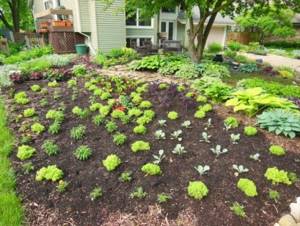
Are you categorically against allocating areas for vegetable gardens?
Then you can make beds right in the middle of the lawn. Of course, they will look unusual, because flower beds usually play this role, but with due care in implementation everything will turn out great. Of course, rectangular shapes in this case can ruin everything, as can high sides.
But the dug-in border and long, winding ridges, in which one crop will be replaced by another, will become the highlight of your site.
Make beds of original shape (triangular, trapezoidal, round, etc.)
Do you want your garden to be unique and noticeable even on Google maps? Then create ridges of unusual shape with a clear outline. You can get by with geometric shapes, or you can create entire paintings.
However, remember that you will still have to take care of such beds, so do not make their elements too large so that later, in attempts to weed the center, you do not trample the edges.
Lay beautiful paths between the beds

Even the most ordinary beds can be made neat by laying permanent paths made of tiles, bricks, pebbles or wood between them. This way you will not only decorate the area, but also stop slipping in the mud after rain, and also dramatically reduce the weeding area. And it will be easier to track and destroy flightless pests on such paths.
Enclose your garden with a beautiful fence or hedge
For those who do not want to change anything in the garden, but are not ready to show off their potatoes and cucumbers to all the guests, the solution will be a small, neat fence separating one zone from another. A fence at the edge of the garden can have both aesthetic and practical functions, for example, to prevent your pets and small children from breaking through to the plantings.
It is not necessary to erect a two-meter solid structure; a wooden, wicker or carbonate fence 50-80 cm high will be sufficient.
Place a bench or deck chair next to the beds
For many summer residents, the sight of beds with a ripening harvest is even more pleasant than flowing water or a burning fire. But it’s better to admire them comfortably, without haste. To do this, equip yourself an observation post next to the garden - install a bench or deck chair.
You can also keep a notepad and pencil there to record all the ideas and plans that come to mind.
Install an arch or pergola with climbing plants at the entrance to the garden
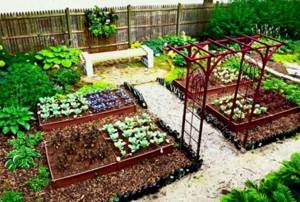
It is possible to visually separate a vegetable garden area without a solid fence. It is enough to mark the entrance by installing a pergola or arch along which decorative or vegetable crops will weave.
The best decorations for such an arch would be maiden grapes, clematis, climbing beans, honeysuckle honeysuckle or hops.
Make the beds narrower and the passages between them wider
Only the lazy have not written about the advantages of narrow beds - they are convenient to process, plants receive more light and air, productivity increases, etc. But it is important not to forget about the wide passages between the ridges.
Overgrown with lawn grass or covered with sand, bark or pebbles, they look neat and turn even banal plantings into a decoration for the garden.
Arrange the beds in the form of a flower bed or alpine slide
Who said cabbage belongs in the garden? It (and other vegetables) may well become elements of flower beds, alpine slides, and mixborders. Moreover, there are vegetables that are truly created to fit perfectly into the flower garden.
These include colorful cherry tomatoes, bush beans with bright leaves, and leafy lettuces.
Build a spiral bed
A spiral bed always looks impressive and can also become the center of a decorative garden. It's not that difficult to create, although it does require some patience. In fact, this is an analogue of an alpine slide, but at the base it does not have stones and sand, but soil and plant debris.
You can lay out the contours of the spiral itself using either wild stone or bricks.
Plant flowers (marigolds, calendula, etc.) around the perimeter of the beds.
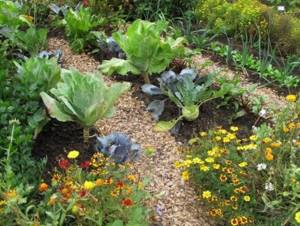
Flowers with a pungent odor planted around the perimeter will decorate and protect any garden bed from insect pests. They are unpretentious, and with the care that you provide to the vegetables, marigolds and calendula will feel at their best and will thank you with abundant flowering until frost.
Use arches as supports for climbing plants
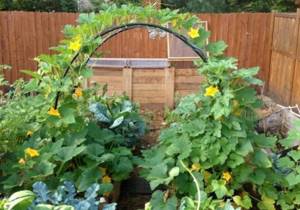
Cucumbers, beans, pumpkin – what do these crops have in common? Of course, long lashes spreading throughout the garden and constantly crawling into other ridges and under your feet. Of course, you can tie up the stems, but you can’t have enough stakes for everything. But plastic or metal arches are inexpensive, last a long time, and cope with the task perfectly.
In addition, ripe vegetables are visible on them much better than on the ground, they do not get dirty and serve as a decoration for the garden.
Build a box bed with a beautiful trellis
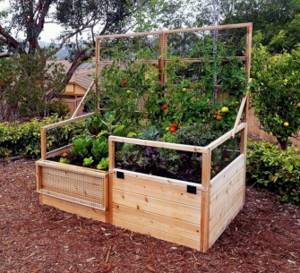
A box bed is also well suited for planting climbing plants and storing plant and food residues. Most often, cucumbers are grown in these, but your imagination may not be limited by anything.
As in the case of high beds made of boards, all wood must first be soaked in antifungal agents and dried thoroughly.
Build a multi-tiered bed
Multi-tiered beds of complex shape are good as a design element, but are quite finicky in matters of care and maintenance. The material for them needs to be chosen of high quality and durable, but it is difficult to grow some large vegetables in such areas - there is not enough space.
It is best to build such a structure for herbs or an apothecary garden.
Make beds from gabions
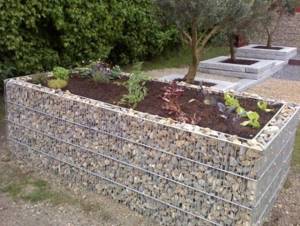
If you have a lot of stones on your site, you are strong and have a lot of free time, you can build a structure made of gabions, which is often seen on city streets. Metal ones are again sold for them in construction and gardening hypermarkets, but the filling will have to be obtained independently.
Of course, such ridges are created to last for centuries, but this has not only advantages, but also disadvantages - moving the planting will not work so easily.
Use unusual objects as a base for your beds (an old boat, bed, wheelbarrow, chest of drawers, etc.)
Old items that have gone out of fashion or become unnecessary can be an excellent container for vegetables. Of course, getting a boat in an area without large bodies of water is not so easy, but everyone has old beds, broken cars or boxes.
Moreover, unnecessary things are often brought to the dacha, and you don’t have to store them in the shed, but give them a second life on the site.
Create beds on a slope

Have you unwittingly become the owner of a plot of land with a slope or ravine?
Don’t despair, terracing and geomats will allow you to turn this unsightly piece into a full-fledged vegetable garden. With the help of supports on the slope, you can hold back the soil, and bushes or ground covers planted in it will help stop the soil from sliding.
Build a gazebo next to your garden
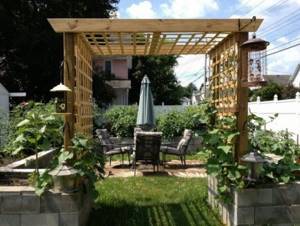
Do you think that one bench near the garden is not enough for you, or do you want to admire the fruits of your labors with the whole family and in any weather?
Then place the gazebo next to the vegetable garden. You can relax in it, read topical magazines, and if you suddenly want to have a snack, you won’t have to go far - all the berries, vegetables and herbs are literally at your feet.
Decorative vegetable garden
You have probably noticed that vegetable and aromatic crops are beautiful both during flowering and during fruiting. Even potatoes bloom with cute flowers, and the rich color of their tops can be the envy of some flowers.
The multi-colored shiny peppers on the bush are beautiful, the red and green tomatoes, even the cucumber bed with plants climbing along the arch looks good.
There are also colorful salads, different types of cabbage, all sorts of parsley, dill and other healthy and fragrant herbs. Aesthetes noticed this and began to decorate the beds beautifully. There are even two different types of ornamental vegetable gardens.
French vegetable garden
In the classic version, these are symmetrical beds, in the center of which there is a sculptural group, a fountain, and another recreation area. Such vegetable gardens were made near castles, and they were also a place of rest. The strict geometry of the planned site further emphasized the splendor of the castle. He was always the priority.

Clearly shaped beds, their boundaries marked by border plantings
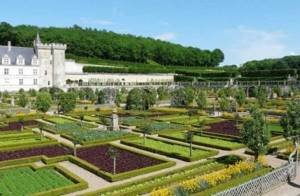
In the modern version, the beds can be square, rectangular, or in the form of a sector of a circle. All of them are separated by clear paths; border plants are planted along the edges of the beds. It’s clear that you can’t install a pure French vegetable garden on your 6-10 acres, but it’s very possible to do something similar.
In general, there are two types of beds - at the same level with the soil and raised.
It is easier to organize a vegetable garden on one level, but raised beds are more convenient to cultivate. To fence them, you can use boards, or slate cut into strips; if desired, the fence can be made of stone or woven from wicker. This is who can or wants to aim at what. For a few examples of how to make a fence for beautiful garden beds, see the photo.

You cut flexible branches from the forest (willow, for example) and while they are fresh, weave a fence for a raised bed
A fence made of boards is quick and easy, you just need to saturate the boards with a bioprotective compound, otherwise they will turn black and be unattractive
For beds at the same level with the ground, plants can be used instead of borders. For example, parsley, regular or curly, lettuce of different colors. It is clear that the plants will be gradually cut off, but you can first plant them densely, gradually thinning out the planting.
If space allows, along the edge of the beds you can plant marigolds or calendula, only a low border, other plants that produce dense greenery and grow small in height.

The main focus of the French vegetable garden is the layout and evenly planted rows. The second is in the alternation of colors. The third is in beautifully made paths that highlight the greenery.
To make everything look beautiful, you need to alternate the shades of plants, and to imagine how everything will look, it is better to draw in color.
They draw as best they can: on a computer in a design program or on a landscape sheet. There you can also develop a layout of the beds yourself if you draw everything to scale. Then the ideas will need to be transferred to the site. There are several options for bed layouts in the photo.

DIY decorative garden
In order to create a decorative vegetable garden, you need to choose plants that can live in a limited space (capable of self-pollinating). These include eggplants and cucumbers, tomatoes and peppers. If the soil is open, then you can use zucchini, cabbage and other vegetables. You can sow onions, dill, parsley and other plants into the ground. In general, the choice of plants depends on the preferences of the homeowner and his family, both aesthetic and culinary.

It’s not difficult to create a decorative vegetable garden with your own hands; just follow a simple plan that includes the following steps:
- Planning and drawing up a project for the future vegetable garden. To do this, it is enough to take a sheet of paper and, on a certain scale, depict the site and the buildings and functional areas on it. Next, the location of the garden is determined, which allows you to plan it efficiently.
- Marking the territory according to the plan. To do this, you can use twine and pegs, with the help of which the boundaries of beds and paths are outlined.
- Installation of the base of the sides at the junction of the beds and paths. If the frame is made of wood, then before starting work the material is treated with special materials and solutions that protect it from moisture and insects, and rot.
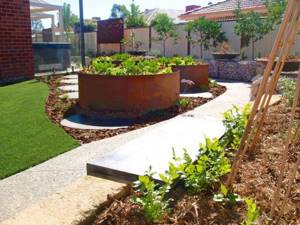
- Digging a “trough” under the base of the paths. The trench must be filled with sand and crushed stone.
- Installation of a wooden frame, fastening the boards with self-tapping screws.
- Wooden logs are laid on top of the crushed stone, on top of which a terrace board can be attached, ensuring comfortable movement around the garden.
- The beds of the ornamental vegetable garden are filled with fertile soil mixed with local soil, after which the soil must be carefully leveled.
- The garden is ready and you can start planting vegetables.
Where to begin
First of all, you need to draw up a plan for your garden. To do this, it is worth answering the following questions.
- Will the vegetable garden occupy the entire area of the plot, or will there be a flower garden, fruit trees, lawn, swimming pool or something else next to it?
- What crops will you grow, what conditions do they need?
- How they fit together: Keep in mind that some plants do not grow well next to each other or may infest each other with pests.
- How will you design the beds, what materials will you use?
- What materials are needed for walkways?
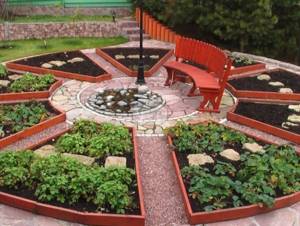
The plan can be drawn up on paper or using a computer. The method is not so important, it is important that in the end you have a detailed landscape design scheme for your plot with a vegetable garden. The plan diagram may look something like the figure. Below, write what each number corresponds to.
You need to mark everything on the plan: the size of the beds, the width of the paths, materials, decorative elements, types of plants. If you are drawing up a plan on a computer, attach a photo to get an idea of what your garden should look like.
It is important to think about which crops will bloom and bear fruit in different seasons, as well as their interchangeability, because as they are used for food, plants may lose their decorative appearance or simply run out.

It is also necessary to provide convenient paths to all areas of the garden. It is better if they are paved with hard material. Make an estimate for setting up your garden. Consider not only the price of plants and materials, but also the cost of delivery and labor.
To work out the technology for setting up an ornamental vegetable garden, I used my own plot.
The decision was made several years ago, when during a 2-year course on landscape architecture at the Nature Conservation Society, the teacher showed us, among others, a slide of a French vegetable garden. I really wanted to do something similar on my site.
My “decorative French vegetable garden” is integrated into the garden as a separate green room.
Its walls are hedges of weeping white willow and brilliant cotoneaster, mixborder, and on the fourth side there are purple bird cherry, common mackerel and vines (maiden grape, yellow-leaved hop, petiole hydrangea).
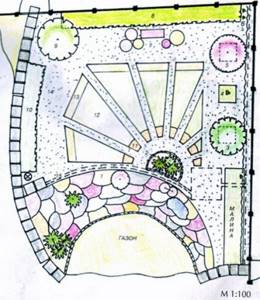
- mixborder
- module with conifers
- Mackerel
- petiolate hydrangea
- purple bird cherry
- girl's grapes, hops
- garden in containers
- cotoneaster hedge
- mock orange
- willow hedge
- miniature rose lined with alyssum
- bed
- padding from flyers
- backfill made of decorative stone wool
- drainage
What plants can be grown
Flowers and vegetables planted in the same bed not only look original, but also interact with each other. Small flowering plants located between the rows of vegetable crops protect the soil from moisture loss and also attract pollinating bees. Some flowers with their scent can repel insect pests, masking the delicious aroma of vegetables for them.
To select plants planted in a decorative bed, their compatibility is taken into account
Watering and fertilizers applied for the development of vegetable crops also go to flowers - in such a community no one is deprived of nutrition and moisture.
Principles of planting plants in a flower bed
For good growth of gardening plantings, it is recommended to plant flowers every 3-4 rows of vegetable crops. Vegetables are placed first in the flowerbed. Once the vegetable seedlings have taken root, you can plant flowers in them. If flower crops are sown with seeds rather than seedlings, then after emergence they need to be thinned out, leaving the required number of the most viable specimens and removing the excess. The distance between each flowering plant should be at least 15–20 cm.
Compatibility of flower and vegetable crops
To get the maximum effect from the community of plants placed in the same flower bed, experienced gardeners advise adhering to the following combinations:
- Marigolds - these flowers have a specific aroma that repels insects. Even when dried, these flowers retain their properties. Externally, flowering marigolds look bright and attractive; they are planted next to cabbage, potatoes, carrots, cucumbers, and legumes.
- Calendula is not only good in the flowerbed and has medicinal properties, but also improves the composition of the soil. The smell of the plant repels slugs and Colorado potato beetles. You can plant calendula with carrots, potatoes, cabbage, cucumbers, and beans.
- Petunia - it is placed next to tomatoes to protect against cicadas and aphid invasion.
- Nasturtium is a bright flowering plant that has a decorative appearance and can even be eaten. Planted between rows of potatoes or cabbage, nasturtium not only fills the gaps, but also masks the vegetable smell with its aroma, protecting cruciferous, pumpkin and nightshade crops from whiteflies.
- Yarrow - Its scent attracts ladybugs, known as aphid eaters. In addition, wasps and bees love to visit fragrant flowers, which simultaneously pollinate fruit plants.
- Borage - blooms with small blue flowers. The leaves are eaten in salads because they have a cucumber-like scent and a delicate texture. The plant helps loosen the soil, is an excellent honey plant and repels Colorado potato beetles with its smell. It can be planted next to any vegetable crops or herbs.
Placing flowers near vegetable crops not only improves the growth of their companion neighbors, but also prevents the spread of weeds. This flower-vegetable community greatly facilitates flowerbed care and creates bright compositions.
Marigolds planted next to cabbage protect it from garden pests
Delphinium, sweet pea, cosmos, and zinnia have proven to be good companions for garden crops - these plants heal the soil and attract bees with their flowers.
Photo: flowers for combination with vegetables

Yarrow repels insect pests

Nasturtium protects against nematodes
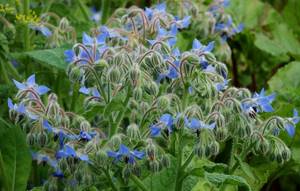
borage is edible

Sweet peas improve soil composition
Bulbous plants can be planted with lettuce and parsley, and carrots look original next to daffodils and tulips. Garden chamomile looks contrasting when planted next to pumpkins, zucchini or cucumbers, and bright parsley with lacy leaves is planted at the foot of roses and chrysanthemums.
Combination of vegetable crops
Vegetable crops differ from each other not only in the time of ripening, but also in the consumption of the amount of nitrogenous components they require. Based on this, only those specimens that have similar requirements for a comfortable living environment can be grown next to each other.
When vegetables are placed together in a garden bed, a certain microclimate is created that improves their growth.
When creating mixed plantings of vegetable crops, you must adhere to the following rules:
- For ease of maintenance, it is recommended to make the width of the bed no more than 1 meter.
- The main crop is planted in the center of the bed, and the accompanying plantings are closer to the edges.
- Soloists choose those vegetables whose ripening period is the longest, for example, tomatoes or peppers. By the time the fruits form, these plants grow greatly.
- By the time the main crop ripens, its companion neighbors will have already been collected and will create the opportunity for air circulation and maximum access to sunlight.
In order not to make a mistake with the right choice of friendly plant species, you can use special compatibility tables for garden crops.

The table gives a visual representation of the compatibility of the main garden crops and spices
Such tables are based on the principle of nitrogen consumption by vegetable crops. For example, cabbage, cucumbers, zucchini, and celery are considered strong consumers of nitrogenous substances; average consumers include potatoes, carrots, spinach, radishes, beets, onions, and legumes and spices require very little nitrogen.
Methods of organizing and styles of decorative gardening
Basic organization techniques
Reception No. 1 Vegetables + flowers
This technique is characterized by a certain stepwise planting of plants. In this case, they are planted in groups of several species. The main feature of this technique is the combination of colors (greens + bright accents on flowering vegetables or ordinary flowers).
The bottom layer should always remain green (you can even use mosses), this will provide a beautiful cushion (if using conifers, save the colors for the winter).

Technique No. 2 Vegetable garden with “walls”
When we create our own piece, we expect it to look great all year long. Only, unfortunately, this is not the case.
In winter and autumn, the garden loses its beautiful appearance; to prevent this from happening, the designers came up with a special technique.
Its essence is that the vegetable garden is created on an elevation, and this elevation is fenced with stonework of different shades (for this you can use colored glass bottles or wooden materials).
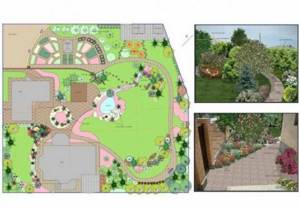
Technique No. 3 Portable decorative vegetable garden
The main advantage of this type of garden design is mobility. It is very simple in design. Photos of containers can be found on any website.
The highlight is that your plants are planted in special pots, which you can even place around the perimeter of the house.
You can use anything for a pot: old clay pots, large plastic containers, plastic pots. Not all plants are suitable for such planting, but cherry tomatoes, eggplants, marigolds, etc. will respond very well to such a “life.”
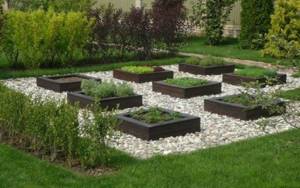
Fencing a vegetable garden is also an art
Not particularly aesthetically pleasing and extremely labor-intensive. As soon as the opportunity arose, everyone tried to abandon vegetable gardening in favor of ornamental gardening, without thinking that it was also possible to grow vegetables beautifully. Decorative vegetable garden is the name of the returning tradition of home garden vegetable growing. It cannot be called new from the point of view of world history - the first “useful” gardens, monasteries and apothecaries, were very close in essence to vegetable gardens. True, in those days in Europe there were not many vegetables that are popular today - tomatoes, cucumbers, potatoes. But there was cabbage and legumes, as well as salad crops and aromatic plants. The layout of the monastery gardens was symmetrical, the ridges were square and small. Due to the well-groomed nature and diversity of the plants grown, they looked almost like flower beds.
Today's ornamental vegetable gardens are much more beautiful than their ancestors. Largely thanks to the efforts of breeders, who have developed many new plant varieties, as well as in connection with the development of agricultural science and the emergence of innovative agricultural practices.
In the phrase “ornamental vegetable garden,” the adjective “ornamental” is more important than the noun “vegetable garden.” The main thing in this case is not to grow a crop of agricultural products, but to have a beautifully decorated space throughout the summer. Based on aesthetic considerations, they choose the location and spatial layout of the ornamental garden, and the selection of plants is not based on their taste or productivity, but on the shape of the bush, the color of the fruits and leaves and other external features.
Layout according to the laws of beauty
The main requirement for a space for a vegetable garden is good lighting. According to this criterion, any vegetable and berry crops should be planted, regardless of whether a purely aesthetic goal is being pursued or a certain “food” program is being implemented. Unlike a useful vegetable garden, which is usually placed behind the house, a decorative one can be laid out even in the front area of the garden, in the foreground, making it the “calling card” of a country home. In this case, the plantings are usually given a regular layout with axial symmetry. Paving becomes an indispensable element - neutral colors and textures are best, if the house is of a classic style, made of stone. And near a wooden cottage you can pave paths in country style: wood, tiles imitating sawed trunks, clinker bricks. A good solution is stone filling.
The distance between the beds should be at least 50–60 cm with the width of the rectangular planting strips from 70 to 120 cm. However, the beds can be not only rectangular, but also square, triangular, round and all sorts of irregular configurations. The main thing is that in any case it is convenient to care for the plants.
Particular attention should be paid to the edges of the ridges: in order to prevent them from crumbling (this is especially undesirable in the front area), sides are definitely needed. Most often they are made of wood, preferably hardwood (larch, for example). In addition, the compositional design of a decorative vegetable garden in the front area can be supplemented with modular beds and containers of various shapes, heights and depths.
Plants of the front area
If we recall classical gardens of a regular style, they always have solitaire plants, that is, growing in the open and attracting the eye. According to the laws of the genre, they are planted symmetrically and carefully cut, trying to ensure that they grow in the same rhythm. In a garden of this style, small fruit trees - cherries, dwarf apple trees, etc. can act as solitary plants. You can place pots with laurel or orange trees in the center of the flower beds, which will migrate into the house for the winter. Fruit bushes (currants, gooseberries) look ideal on a trunk: a bare trunk about a meter high and branches hanging down, which by the end of summer will be decorated with beautiful berries.
In general, the most beautiful and even ceremonial plants are chosen for the front garden. In the beds that act as parterre flower beds, it is best to plant vegetables that are distinguished by their beauty throughout the growing season. These are mainly green and spicy-flavoring crops. Along the perimeter of the ridges, low varieties of onions will look good, since their “feathers” hold their linear shape well and do not tend to grow in clusters. Berry bushes are suitable as border plants: blueberries, blueberries, etc. In the center of the bed or in the background, if the bed is adjacent to the wall of a building or fence, it would be good to plant relatively tall crops with beautiful leaves - these could be spicy plants, for example lemon balm, or such garden “ordinaries” as horseradish or young rhubarb, with their surprisingly decorative greenery. In addition, we can recommend fragrant rue with bluish-green leaves, mint with white-edged foliage, clary sage with silvery pubescent leaves, purple-leaved or yellow-edged sage, red garden quinoa, oregano with golden foliage or its white-variegated form, and sorrel with red petioles. and red veining of the leaves.
The entire space from the strip around the perimeter to the tallest plants of the garden bed can be planted with green crops. Salads (leaf, cabbage and others) with a variety of leaf shapes (whole-edged, dissected into lobes, with a jagged or wavy edge) and color (green, dark green, reddish, dark red, yellowish, bright green with burgundy) will be good stripe along the edge). In addition, curly leaf parsley looks good in such plantings; basil with different colored leaves, dill, asparagus, carrots (the lacy foliage of the last three crops adds airiness to the compositions).
Within the style
If we talk about decorative vegetable gardens for “pragmatic” purposes, they are located anywhere: next to outbuildings, along a fence, in a separate “green room” (in a small area of the garden, fenced off from other space by a hedge) and even on the roofs. The latter planting option even has historical Russian roots: once upon a time in Rus' there were so-called “horse” pleasure gardens, created at princely mansions on special stone vaults. In the 17th century, there were several such gardens in the Kremlin, where, among other plants, fruits and berries and green crops were grown.
However, despite the variety of options, most often modern vegetable gardens, in which not only greens are grown, but also “fruit” plants, such as tomatoes, peppers, eggplants, etc., are laid out near the summer kitchen or near the house, so that the wall protects vegetables from cold winds and bad weather.
If mainly green crops are recommended for ceremonial areas, then in all other ornamental gardens vegetables that become especially attractive during fruiting will dominate: tomatoes, eggplants, peppers, zucchini, pumpkin, cabbage, etc.
Tomatoes are selected early ripening and preferably with fruits of unusual colors - orange, yellow, pink and purple. If the fruits are red, then let them be distinguished by their shape - cylindrical, plum-shaped, pear-shaped, etc. Tomatoes can also be very different in the shape of the bush: standard, semi-standard, lodging...
Eggplants and peppers are often grown in greenhouses. But if the seedlings were planted early and grew strong and healthy, there is a chance to get a harvest without shelter. These crops are also very diverse in the shape of the fruits and their colors and can decorate any corner of the garden, but, however, closer to autumn.
We should not forget about cabbage and legumes, cucumbers, beets, carrots, turnips, bush zucchini, pumpkin, corn and other “goodies”. The main thing is to follow the rules of plant compatibility, for example, remember that onions and garlic grow poorly next to peas and beans, but thrive near strawberries and carrots, and cucumbers, on the contrary, live well next to peas, beans, garlic, but do not get along with potatoes. Plants of the same family (for example, parsley and carrots) should not be planted in the same bed due to the risk of spreading pests and diseases. Also, in the summer, you should think about where which vegetables will grow next year, since crops must certainly be rotated, but, again, with certain knowledge.
Such vegetable gardens can even be given the features of a particular garden style. And believe me, it will not only be country, although, of course, the rustic style is the most organic in this case. Vegetable plantings can also have a landscape character - crops such as rhubarb, asparagus, and aromatic plants are especially good for them. And, oddly enough, decorative vegetable gardens of an avant-garde nature are extremely impressive - in combination with sculpture, glass, metal, etc. Here the importance of vegetable crops as ingredients of culinary delights is barely visible - they are so magnificent in the context of avant-garde compositions...
Vegetable garden vertically
The vertical component is extremely important in any garden. It is impossible to overestimate its importance for the ornamental garden.
In a similar capacity, tall varieties of corn, tall cultivated cereals, legumes stretching up the supports, as well as hanging vegetable and berry crops (canopy - plants with drooping shoots, usually planted in hanging containers) can be used. The latter, for example, include garden strawberries and tomatoes, of which many hanging varieties have been bred. Baskets for vegetables are used the same as for decorative flowers: they are made of wire, lined with coconut fibers or moss and filled with soil. Vegetables (seedlings) are planted in such baskets from the outside, mainly from the sides, by cutting holes in the moss or coconut fiber with a knife.
In addition to hanging pots, tiered containers standing on the ground are also used for decorative vegetables. In addition, any pergolas, arches, gazebos, canopies over benches and fences can be covered not with flowers, but with climbing bean plants (bean pods, by the way, are not only green, but also yellow, purple, reddish, etc.) , lashes of cucumbers or pumpkins with medium-sized fruits.
The idea of a vegetable garden is that well-forgotten old thing that is quite capable of passing for something new. Europe has already acquired a taste for ornamental plantings that “would just as soon be eaten.” Now it’s up to the Russians: as you know, they harness for a long time, but drive quickly, and a “stop” near an ornamental garden is by no means the worst prospect...
zagorod.spb.ru
Decorative garden: which plants to choose?
Many people wonder what types of plants are suitable. Look at the photo of an existing garden - everything you need is there. The ability to combine plants in your composition is very necessary.
The main conditions are the need to combine them by:
- the extent of flowering and ripening;
- care needs;
- degree and type of care.
You can use for bottom layers or garden edging:
- basil,
- lemon balm,
- cilantro,
- parsley
For the main plants that will form the basis of your composition, you can use:
- tomatoes,
- pepper,
- cabbage,
- corn,
- pumpkin
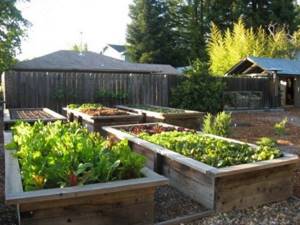
You can use any greenery both as decorative elements and decorations, and as an independent part of the composition. For example, by planting these plants in a circle or oval, you will give them a completely new look.
Advice: before planting any plants, check whether they will “conflict” with each other and whether the selected plants will take all the beneficial substances from the soil and deplete it.
It is for such cases that we told you about the free spaces in the ornamental garden - they make it possible to temporarily replant plants to fertilize and restore the soil.
Decorative vegetable garden: the feasibility of its use
Recently, growing your own fruits and vegetables in your summer cottage has become a popular and even fashionable trend.
And this is not unreasonable, since you know for sure that you did not poison your vegetables with nitrates, did not use growth enhancers, and even if you used drugs to protect plants from pests, then these were probably organic products that were safe for humans.
When a person was fed up with all the “chemicals” that are offered in supermarkets and even in markets, then he realized that for his personal use of vegetables and fruits he does not need so much and that all this can be grown on his own plot without making Herculean efforts.
And when I suddenly realized that lettuce leaves are like bright flowers, green cucumbers grow no worse than morning glory, and flirty cherry tomatoes can decorate even a flower bed, then the realization came that it was time to start growing not only flowers, but also berries and vegetables .
The most important requirements for a modern ornamental garden are that it requires minimal care, and also brings not only aesthetic pleasure, but also practical benefits in the form of ripe and juicy fruits.
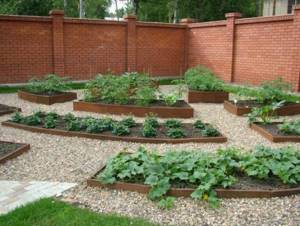
Ornamental vegetable garden - what is it?
The term “decorative” usually means a vegetable garden with a high level of improvement (garden paths and high beds with sides, “main” structures and beds of original shape). An equally important condition for creating a decorative garden is the presence of flowers (annual and perennial), which make up about 10% of all plants in the garden.

To create a garden of this type, vegetables and other crops are used, intended not for consumption, but for decorating the site. For example, you can use sunflowers and tomatoes, various types of lettuce and corn. If you go to a gardening store, you can find a wide range of plants, which will allow everyone to choose the best option. At the same time, experts recommend not using plants with inedible or poisonous fruits, because this can be misleading for both adults and children.
